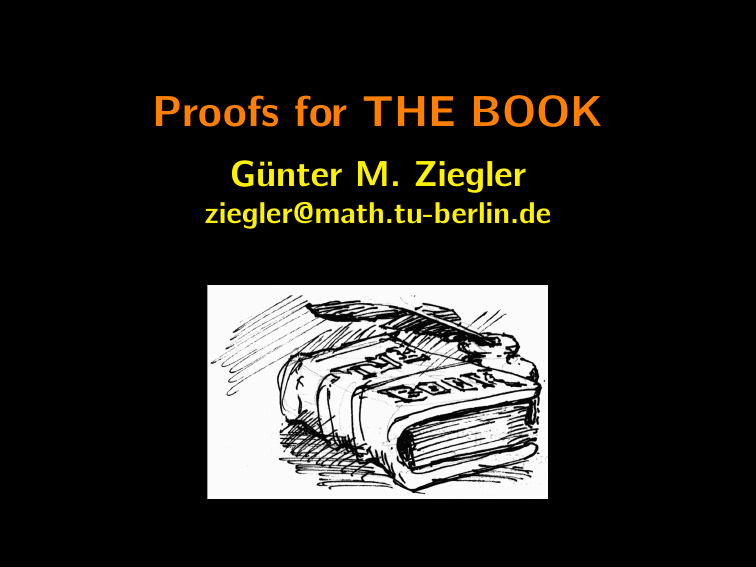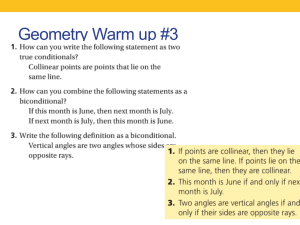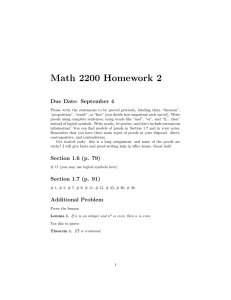Proofs for THE BOOK
advertisement

Proofs for THE BOOK
Günter M. Ziegler
ziegler@math.tu-berlin.de
Plan
1. On Proofs
2. The BOOK of Proofs
3. Two-Coloring Proofs
4. Odd Dissections of a Square
5. Enumerating the Rationals
6. Kneser’s Conjecture
7. Places
Plan
1. On Proofs
2. The BOOK of Proofs
3. Two-Coloring Proofs
4. Odd Dissections of a Square
5. Enumerating the Rationals
6. Kneser’s Conjecture
7. Places
Thesis 1: Mathematics is difficult!
Figure: Pixelio.de
“I hope that the popular press will continue
to portray mathematics as being like a
diamond:
extremely hard material, but valuable and
highly prized both for its industrial
applications and for its intrinsic beauty.”
— Prof. Harold P. Boas, 2003
Thesis 2: There are many types of proof
amazon.de
Thesis 2: There are many types of proof
amazon.de
BOOK Proofs . . .
http://www.jwuniverse.co.uk/
Thesis 2: There are many types of proof
simple
surprisingly simple
short
with an idea
entertaining
correct
elementary
“trivial”
using a computer
new
geometric
—
—
—
—
—
—
—
—
—
—
—
...
complicated
surprisingly complicated
long
routine
boring
nearly correct (= wrong)
technical
tricky
visual
old
algebraic
Thesis 3: Proofs have history
The “Four Color Theorem”
— Guthrie 1852
— Kempe 1879 : Heawood 1890
— Heesch 1969 — Appel, Haken, Koch, 1976
— Robertson, Sanders, Seymour, Thomas, 1996
— Werner, Gonthier 2004
http://www.freewebs.com/desargues/4ct1.htm
Thesis 3: Proofs have history
The “Four Color Theorem”
— Guthrie 1852
— Kempe 1879 : Heawood 1890
— Heesch 1969 — Appel, Haken, Koch, 1976
— Robertson, Sanders, Seymour, Thomas, 1996
— Werner, Gonthier 2004
http://mathworld.wolfram.com/Four-ColorTheorem.html
Thesis 3: Proofs have history
The “Four Color Theorem”
— Guthrie 1852
— Kempe 1879 : Heawood 1890
— Heesch 1969 — Appel, Haken, Koch, 1976
— Robertson, Sanders, Seymour, Thomas, 1996
— Werner, Gonthier 2004
http://mathworld.wolfram.com/Four-ColorTheorem.html
Thesis 3: Proofs have history
“Fermat’s Last Theorem”:
For n ≥ 3
xn + yn
= zn
has no solutions
in positive integers
x, y and z.
— Fermat, 1637
— Wiles, Taylor 1993
(published 1995).
http://www.amazon.com
Thesis 4: We need proofs
The equation
z3 = x3 + y3
has no solution.
(Euler 1753)
Thesis 4: We need proofs
The equation
z3 = x3 + y3
has no solution.
(Euler 1753)
The equation
z 4 = x 4 + y 4 + u4
has no solution either?
(Euler 1772)
Thesis 4: We need proofs
The equation
z3 = x3 + y3
has no solution.
(Euler 1753)
The equation
z 4 = x 4 + y 4 + u4
has no solution either?
(Euler 1772)
. . . it does:
4224814 = 958004 + 2175194 + 4145604 !
(Elkies 1986)
Thesis 4: We need proofs
http://rjlipton.wordpress.com/
Thesis 5:
Proofs should not be done in public!
“Proofs should be communicated only by consenting adults
in private”
— Victor Klee (U. Washington)
Oberwolfach photo library, http://www.mfo.de
Thesis 5:
Proofs should not be done in public!
Sidney Harris book cover, http://www.amazon.com
Thesis 5:
Proofs should not be done in public!
K. H. Hofmann for “Proofs from THE BOOK”
Plan
1. On Proofs
2. The BOOK of Proofs
3. Two-Coloring Proofs
4. Odd Dissections of a Square
5. Enumerating the Rationals
6. Kneser’s Conjecture
7. Places
THE BOOK of Proofs . . .
Paul Erdős (1913-1996) Oberwolfach photo library, http://www.mfo.de
K. H. Hofmann for “Proofs from THE BOOK”
THE BOOK of Proofs . . .
THE BOOK of Proofs . . .
Plan
1. On Proofs
2. The BOOK of Proofs
3. Two-Coloring Proofs
4. Odd Dissections of a Square
5. Enumerating the Rationals
6. Kneser’s Conjecture
7. Places
Two-Coloring Proofs
Theorem.
The “chessboard without corners”
cannot be covered by dominos.
Proof:
Two-Coloring Proofs
Theorem.
The “chessboard without corners”
cannot be covered by dominos.
Proof:
Two-Coloring Proofs
Theorem.
The “10 × 10 chessboard”
cannot be covered by quadrominos.
Proof:
Two-Coloring Proofs
Theorem.
The “10 × 10 chessboard”
cannot be covered by quadrominos.
Proof:
Two-Coloring Proofs
Theorem. [Conway & Lagarias 1990]
The following board cannot be covered by triminos.
Two-Coloring Proofs
Theorem. [Conway & Lagarias 1990]
The following board cannot be covered by triminos.
. . . and there is no coloring proof for this!
Two-Coloring Proofs
Theorem. [Conway & Lagarias 1990]
The following board cannot be covered by triminos.
. . . and there is no coloring proof for this!
Two-Coloring Proofs
Theorem. [Conway & Lagarias 1990]
The following board cannot be covered by triminos.
. . . and there is no coloring proof for this!
Two-Coloring Proofs
Theorem. [Conway & Lagarias 1990]
The triangular board cannot be covered by triminos.
Proofs:
• group-theoretic proof
(using “Conway’s tiling group”, 1990)
• elementary proof
(by Doug West, 1991)
Plan
1. On Proofs
2. The BOOK of Proofs
3. Two-Coloring Proofs
4. Odd Dissections of a Square
5. Enumerating the Rationals
6. Kneser’s Conjecture
7. Places
Odd Dissections of a Square
Theorem. [Thomas 1968/Monsky 1970]
A square cannot be cut into an odd number of equal-area
triangles!
Odd Dissections of a Square
Proof — Part 1: We color the rational plane:
[Thomas 1968/Lenstra]
Color a point (x, y ) according to which entry of
a c
(x, y , 1) = ( , , 1)
b d
is the oddest
(that is, contains the largest power of 2 in the denominator):
• blue: if x is the oddest of the three numbers,
• green: if y is odder than x and at least as odd as 1,
• red: if both x and y have an even numerator.
Odd Dissections of a Square
Color the plane:
Postscript graphics by Ronald Wotzlaw
Odd Dissections of a Square
Color the plane:
Odd Dissections of a Square
Lemma 1: On any line there are only two colors.
Postscript graphics by Ronald Wotzlaw
Odd Dissections of a Square
Lemma 2: Every dissection has a rainbow triangle!
Odd Dissections of a Square
Lemma 2: Every dissection has a rainbow triangle!
Odd Dissections of a Square
Lemma 3: The area A =
even denominator.
p
of any rainbow triangle has
q
Odd Dissections of a Square
Lemma 3: The area A =
p
of any rainbow triangle has
q
even denominator.
Using the 2-adic valuation of the reals
to measure how odd a real number is
the whole plane can be colored so that
• the corners of the unit square have the right colors,
• every line has only two different colors, and
• no rainbow triangle has area
1
2n+1 .
Odd Dissections of a Square
Lemma 3: The area A =
p
of any rainbow triangle has
q
even denominator.
Using the 2-adic valuation of the reals
to measure how odd a real number is
the whole plane can be colored so that
• the corners of the unit square have the right colors,
• every line has only two different colors, and
• no rainbow triangle has area
1
2n+1 .
Thus a square cannot be divided into triangles of area
1
2n+1 !
Plan
1. On Proofs
2. The BOOK of Proofs
3. Two-Coloring Proofs
4. Odd Dissections of a Square
5. Enumerating the Rationals
6. Kneser’s Conjecture
7. Places
Enumerating the Rationals
Cantor: The fractions can be enumerated!
Georg Cantor (1845–1918)
Enumerating the Rationals
Cantor: The fractions can be enumerated!
Cantor: The reals cannot be enumerated!
Georg Cantor (1845–1918)
Enumerating the Rationals
Cantor: The fractions can be enumerated!
1
1
1
2
1
3
1
4
1
5
2
1
2
2
2
3
2
4
2
5
3
1
3
2
3
3
3
4
4
1
4
2
4
3
5
1
5
2
6
1
1
6
! Proof. By lis
figure in the mar
that Q+ is count
− pq right after pq .
Q = {0, 1,
Another way to i
The union of
Indeed, set Mn =
∞
!
n=1
Mn =
precisely as befo
Let us contempl
more. Looking a
r+s
s
1+x
We now use this to generate
even larger infinite binary tree (without a
Enumerating
the anRationals
root) as follows:
[Calkin–Wilf 2000]
0
1
...
0
1
1
1
1
1
1
2
1
2
2
1
3
2
1
3
3
1
3
4
1
4
4
1
1
5
4
3
...
3
5
2
5
3
1
5
3
2
1
1
3
2
3
5
2
...
3
4
1
4
4 1
1 5
3
2
4
3
3
5
...
...
2
3
5
2
2
5
3
1
5
3
3
4
...
4
1
...
Enumerating the Rationals
Theorem. The rule
n ba
7−→
1
n+1−
a
b
generates the sequence
1
1
7→
1
2
7→
2
1
7→
1
3
7→
3
2
7→
2
3
7→
3
1
7→
1
4
7→
4
3
7→ . . .
which contains every positive fraction exactly once.
[Moshe Newman]
Plan
1. On Proofs
2. The BOOK of Proofs
3. Two-Coloring Proofs
4. Odd Dissections of a Square
5. Enumerating the Rationals
6. Kneser’s Conjecture
7. Places
Kneser’s Conjecture
Kneser graph KG (5, 2): the “Petersen graph”
Kneser’s Conjecture
Kneser graph KG (5, 2) colored:
Kneser’s Conjecture
Kneser graph KG (5, 2) colored:
Kneser’s Conjecture
The graphs KG (n, k) can be colored by n − 2k + 2 colors.
Kneser’s conjecture (1955): Less colors don’t suffice
Oberwolfach photo library, http://www.mfo.de
Kneser’s Conjecture
Proofs:
László Lovász (1978)
Oberwolfach photo library, http://www.mfo.de
Kneser’s Conjecture
Proofs:
László Lovász (1978)
. . . using the Borsuk–Ulam Theorem
Oberwolfach photo library, http://www.mfo.de
Kneser’s Conjecture
Proofs:
László Lovász (1978)
. . . using the Borsuk–Ulam Theorem
Imre Bárány (1978)
Oberwolfach photo library, http://www.mfo.de
Kneser’s Conjecture
Proofs:
László Lovász (1978)
. . . using the Borsuk–Ulam Theorem
Imre Bárány (1978)
. . . using the Borsuk–Ulam Theorem
Oberwolfach photo library, http://www.mfo.de
Kneser’s Conjecture
Proofs:
László Lovász (1978)
. . . using the Borsuk–Ulam Theorem
Imre Bárány (1978)
. . . using the Borsuk–Ulam Theorem
Josh Greene (2002)
Oberwolfach photo library, http://www.mfo.de
Kneser’s Conjecture
Proofs:
László Lovász (1978)
. . . using the Borsuk–Ulam Theorem
Imre Bárány (1978)
. . . using the Borsuk–Ulam Theorem
Josh Greene (2002)
. . . using the Borsuk–Ulam Theorem
Oberwolfach photo library, http://www.mfo.de
Kneser’s Conjecture
http://www.ebay.de
Kneser’s Conjecture
Proof: Let X be a set of n points in general position on an
(n − 2k + 1)-dimensional sphere.
Assume there is a coloring
n
k −→ {1, 2, . . . , n − 2k + 1}.
Define
Ai := {x ∈ S n−2k+1 : the open hemisphere Hx with pole x
contains a k-subset of X of color i } .
for i = 1, 2, . . . , n − 2k + 1, and
A0 := {all points on the sphere not covered by these}.
Kneser’s Conjecture
[Lyusternik-Shnirel’man 1930]
The Borsuk–Ulam Theorem:
If you cover the d-sphere by d + 1 sets,
all of them open, or all of them closed,
then one of the sets contains antipodal points.
Kneser’s Conjecture
[Greene 2002]
The Borsuk–Ulam Theorem:
If you cover the d-sphere by d + 1 sets,
all of them either open or closed,
then one of the sets contains antipodal points.
Kneser’s Conjecture
[PFTB 2009]
The Borsuk–Ulam Theorem:
If you cover the d-sphere by d + 1 sets,
all but one of which are either open or closed,
then one of the sets contains antipodal points.
Plan
1. On Proofs
2. The BOOK of Proofs
3. Two-Coloring Proofs
4. Odd Dissections of a Square
5. Enumerating the Rationals
6. Kneser’s Conjecture
7. Places
Places
At the desk:
“The mathematician is a mythological beast:
half chair, half human.”
— Simon Golin
Places
At the coffee machine:
“A mathematician is a machine
that converts coffee into theorems.”
— Paul Erdős
Places
In the library:
Places
In the library:
In bed:
Places
In the library:
In bed:
In church:
Places
In the library:
In bed:
In church:
On the beach:
Places
In the library:
In bed:
In church:
On the beach:
etc.!
Places
Foto: Sven Paustian/Piper
Places
Berlin Mathematical School, http://www.math-berlin.de
K. H. Hofmann for “Proofs from THE BOOK”
Acknowledgement:
I am grateful to all friends and colleagues who contributed to this
presentation. I have attempted to give picture credits for the materials
used for these lecture slides as complete as possible. However, for some
of the figures I do not know or remember or have access to the original
source. In case you have right on any of the pictures used in the
presentation, if they are copyrighted, or not given with the right credits,
please let me know - I will correct this and/or remove them immediately.
Günter M. Ziegler (ziegler[at]math.tu-berlin.de)



